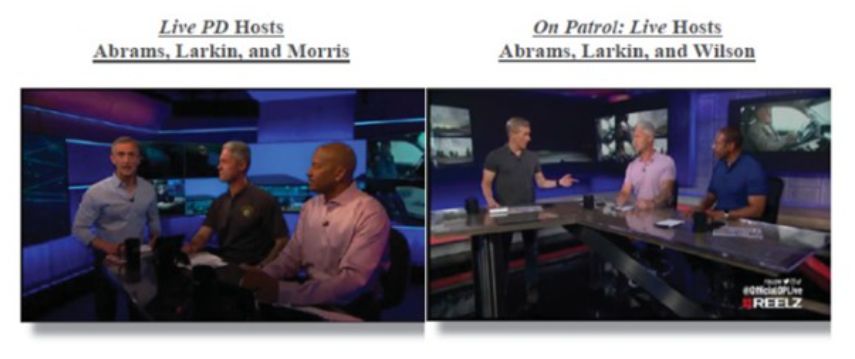On this week's episode, we have the plaintiff A&E Television Networks, LLC ("A&E") facing defendants Big Fish Entertainment, LLC ("Big Fish"), Half Moon Pictures, LLC, and REELZCHANNEL, LLC in a dispute over the alleged infringement of A&E's copyright and trademark rights related to the hit show Live PD.
Live PD aired on the cable network A&E from 2016 through 2020 and featured live videos of law enforcement activity across America, along with narration by host Dan Abrams and others. It was produced by Big Fish for A&E, but pursuant to the parties' agreement, A&E retained exclusive ownership over the copyright and trademark rights associated with the show. Two years after Live PD went off air, Big Fish and Half Moon Pictures developed and produced On Patrol: Live. The new show was promoted by and broadcast on the competing cable network REELZ. On Patrol: Live was nearly identical to Live PD except for a small number of changes. Moreover, the advertisements for On Patrol: Live included statements implying that it was a reboot of Live PD, rather than a completely different show.
A&E brought claims of copyright infringement, trademark infringement, and unfair competition against Big Fish, Half Moon Pictures, and REELZ.

A&E Adequately Pleaded Big Fish Infringed Live PD Copyright
A&E allege that Big Fish infringed its copyright in episodes of Live PD. The parties did not dispute that A&E owned a valid copyright registration for episodes of Live PD and that Big Fish engaged in actual copying. The issue for the court was, therefore, whether the elements of Live PD that were copied were sufficiently original to merit protection or whether they were mere ideas common to any unscripted police show and not entitled to copyright protection. On Big Fish's motion to dismiss for failure to state a claim, the SDNY compared the overall look and feel of the two works and used its "good eyes and common sense" to determine the copyrightability of the allegedly infringed work. In denying Big Fish's motion, the court concluded that Big Fish's "wholesale duplication" went beyond permissible imitation and infringed original expression embodied in Live PD.
The court first found that certain elements of Live PD, when considered together, constituted original expression subject to copyright protection. Though the idea of an unscripted police show is not copyrightable, the court held that Live PD's combination of the live police footage and in-studio commentary along with the specific production choices of the show (e.g., the black screen displaying a message regarding a suspect's innocence in white text each time the show begins or returns from a break; hosts Dan Abrams and Sgt. Sean "Sticks" Larkin, sitting around a virtually identical table with virtually identical mugs; and following specific police departments across weeks), when considered together, were sufficiently creative to support a cognizable, "albeit thin," copyright claim for each episode.
The court then evaluated the similarities between Live PD and On Patrol: Live. The court found that there was substantial similarity because nearly every element from Live PD was replicated in On Patrol: Live. A&E demonstrated that both shows began with nearly identical fast-paced music while a black screen displayed the disclaimer in white letters and virtually identical font; both shows jumped between live or pre-filmed police footage and studio commentary; both shows featured Dan Abrams as the primary host and Sgt. Larkin as the co-host; and segments with identical titles such as "Crime of the Week" or "Missing" were interspersed in each show.
The court did note that, because A&E's copyright protection for Live PD was thin, only very close copying would allow the copyright claim to survive dismissal. Big Fish argued that the differences between Live PD and On Patrol: Live - including that the On Patrol: Live hosts wore polo shirts instead of suits; that the hosts changed positions around a desk; and that the "Crime of the Week" segments used a different font and layout - were sufficient to distinguish On Patrol: Live from A&E's Live PD show. The court disagreed, holding that the "slight" changes of clothes, fonts, and seat positions were not enough to avoid a finding of substantial similarity. Additionally, Big Fish argued that an individual host of a show is not subject to copyright protection. The court agreed that the idea of featuring Dan Abrams as the host could not be copyrighted. However, his appearance in a particular role, at a particular desk, and surrounded by particular show elements was sufficiently original to merit protection, and because On Patrol: Live duplicated all of those elements, Dan Abram's role in On Patrol: Live was substantially similar to his role in Live PD and contributed to the finding of infringement.
In sum, the court held that A&E plausibly pleaded a claim for copyright infringement by showing it had a protectable, though thin, copyright in the collective elements of Live PD and that the similarity between Live PD and On Patrol: Live was substantial.
A&E Adequately Pleaded Big Fish Infringed LIVE PD Trademarks
The court next turned to A&E's trademark infringement and unfair competition claims. A&E's main complaint was that a working title of On Patrol: Live was "PD Live" and that advertisements for the show misleadingly characterized it as a return of Live PD (e.g., "REELZ ADDS #1 TV SHOW TO OUR PROGRAM LINEUP" with "ALL NEW EPISODES"). Moreover, host Dan Abrams posted several Tweets stating "Live PD is back." Big Fish argued that the use of the LIVE PD mark constituted nominative fair use. The court weighed the likelihood of confusion factors and the nominative fair use factors and held that A&E had adequately pleaded its trademark infringement claim.
After determining that A&E owned a valid trademark registration for LIVE PD, the court looked to the eight factors used by the Second Circuit to determine likelihood of confusion. These factors are (1) the strength of the mark; (2) similarity of the marks; (3) proximity of the products and their competitiveness; (4) evidence that the senior user may "bridge the gap" by developing a product for sale in the alleged infringer's product; (5) evidence of actual consumer confusion; (6) evidence that the imitative mark was adopted in bad faith; (7) the respective quality of the products; and (8) the sophistication of consumers in the relevant market. Here, the court found that while each party came out ahead on some of the factors, on balance, the test favored A&E, particularly because the court was obligated to consider the facts in the light most favorable to nonmovant, A&E.
The court found that A&E's LIVE PD mark was strong and that A&E had plausibly alleged that the parties' services overlapped. With regard to the similarity of the marks, the court focused on A&E's LIVE PD mark and its spinoff show LIVE PD: POLICE PATROL, and found that the shared words LIVE and PATROL were insufficient to render them similar to Big Fish's ON PATROL: LIVE. The court rejected A&E's attempt to focus the comparison on Big Fish's internal use of PD LIVE as a working title for its show, since the internal use would not impact consumers. The court did, however, cite the working title in support of its finding that Big Fish had acted in bad faith.
After evaluating the eight likelihood of confusion factors and finding that they weighed in favor of A&E, the court turned to consideration of the three-factor test for Big Fish's nominative fair use defense. The nominative fair use factors are: (i) "whether the use of the plaintiff's mark is necessary to describe both the plaintiff's product or service and the defendant's product or service, that is, whether the product or service is not readily identifiable without the use of the mark"; (ii) "whether the defendant uses only so much of the plaintiff's mark as is necessary to identify the product or service"; and (iii) "whether the defendant did anything that would, in conjunction with the mark, suggest sponsorship or endorsement by the plaintiff holder, that is, whether the defendant's conduct or language reflects the true or accurate relationship between plaintiff's and defendant's products or services."
In this context, the court focused not on the actual name of Big Fish's show, ON PATROL: LIVE, but rather on its use of A&E's exact mark, LIVE PD, in its marketing.
The court held that the first factor of nominative fair use weighed in favor of Big Fish because there was no way to mention that both television shows had the same producer without mentioning Live PD. However, the court found that the second and third factors favored A&E because Big Fish used more of A&E's mark than necessary and misrepresented the relationship between the parties. Specifically, Big Fish's public statements about Live PD "making its return" were unnecessary to identify On Patrol: Live, and its advertisements claiming that "'all new live episodes' of that '#1 TV show' would be airing on REELZ" were "willfully and intentionally" used to confuse the public as to the affiliation and sponsorship of Big Fish's show. In light of this analysis, the court concluded that the nominative fair use defense did not apply on the face of the complaint and held that A&E had adequately stated its claims for trademark infringement and unfair competition.
The case is A&E Television Networks, LLC v. Big Fish Ent., LLC, 2023 WL 4053871, 22 Civ. 7411 (KPF) (S.D.N.Y. June 16, 2023).
Co-authored with Caroline Segers who is a Summer Associate at Finnegan.
The content of this article is intended to provide a general guide to the subject matter. Specialist advice should be sought about your specific circumstances.
